Nancy Marie Brown's Blog, page 14
July 24, 2013
Where Was the Vikings' Vinland?
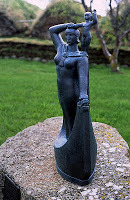 A thousand years ago, an Icelandic woman named Gudrid the Far-Traveler sailed west from Greenland with her husband, Thorfinn Karlsefni. They spent three years exploring North America then, after a clash with Native Americans, returned home to Iceland. As I wrote in
The Far Traveler: Voyages of a Viking Woman
, their story is told in two medieval Icelandic sagas: The Saga of Eirik the Red and The Saga of the Greenlanders.
A thousand years ago, an Icelandic woman named Gudrid the Far-Traveler sailed west from Greenland with her husband, Thorfinn Karlsefni. They spent three years exploring North America then, after a clash with Native Americans, returned home to Iceland. As I wrote in
The Far Traveler: Voyages of a Viking Woman
, their story is told in two medieval Icelandic sagas: The Saga of Eirik the Red and The Saga of the Greenlanders.It is also backed up by archaeology.
Since they were discovered in the late 1960s, the Viking ruins at L'Anse aux Meadows in Newfoundland, and the artifacts found in or near them, have provided more and more proof that the stories in the sagas are true. A particularly intriguing tale is told by the collection of strike-a-lights—shards of jasper, a reddish flinty stone that, struck with steel, creates sparks to start a fire.
When I was working on The Far Traveler in 2006, 10 strike-a-lights had been discovered in the three Viking houses.
I discussed them with Birgitta Wallace, who for a long time was head archaeologist at L'Anse aux Meadows. (I've blogged about her work before: see "The Case of the Butternuts" and "A Viking Woman in America.")
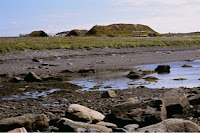 Birgitta Wallace believes the L'Anse aux Meadows ruins were the houses the sagas say Leif Eiriksson agreed to lend—but not give—to Gudrid and Karlsefni. She writes in the book Vinland Revisited: "It is far too substantial and complex a site not to be mentioned in the sagas." It is like other gateways in the Viking world, where a king or chieftain will lay claim to a rich region and seek to funnel all its resources to one spot, where he or a trusted deputy can tax them more easily.
Birgitta Wallace believes the L'Anse aux Meadows ruins were the houses the sagas say Leif Eiriksson agreed to lend—but not give—to Gudrid and Karlsefni. She writes in the book Vinland Revisited: "It is far too substantial and complex a site not to be mentioned in the sagas." It is like other gateways in the Viking world, where a king or chieftain will lay claim to a rich region and seek to funnel all its resources to one spot, where he or a trusted deputy can tax them more easily.This gateway did have a strong leader, someone who divided the work of repairing a small boat among the three houses. As the pattern of artifacts shows, the men in the southern house smelted the ore and fashioned the nails. They worked the wood in the middle house. In the boatshed attached to the northern house, they pried off the broken piece and nailed on the patch.
But was that leader Leif, or Karlsefni? Leif did not have 90 men to build such sturdy houses, according to the sagas; Karlsefni did.
Then there's the jasper evidence. Knowing that jasper varies in its chemical makeup, geochemists compared the trace elements in the 10 strike-a-lights to jasper from Iceland, Greenland, and Newfoundland, as well as to samples from Norway, Nova Scotia, New Brunswick, New England, Pennsylvania, and the Great Lakes region. Four of the strike-a-lights came from Greenland. Five came from Iceland. One was Newfoundland stone.
The strike-a-lights had been recovered from the floors of the houses. The southern house held only Icelandic jasper; the middle house had Icelandic and Newfoundland jaspers; the northern house, Icelandic and Greenlandic. In The Saga of Eirik the Red, Karlsefni's expedition had three ships: two crewed by Icelanders, and one, Gudrid's ship, that was "mostly" Greenlanders. Those ten bits of jasper seem to assert Karlsefni's claim.
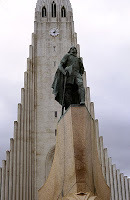 Which does not push Leif Eiriksson out of the picture. His crew might have wintered here, building themselves a sturdy longhouse and some outbuildings. When Karlsefni and Gudrid arrived four years later, with three ship’s crews to house, perhaps they enlarged the settlement. Birgitta Wallace agrees we will never know. "In archaeology, it doesn't really matter if the houses were built 10 years apart—that’s simultaneous to us."
Which does not push Leif Eiriksson out of the picture. His crew might have wintered here, building themselves a sturdy longhouse and some outbuildings. When Karlsefni and Gudrid arrived four years later, with three ship’s crews to house, perhaps they enlarged the settlement. Birgitta Wallace agrees we will never know. "In archaeology, it doesn't really matter if the houses were built 10 years apart—that’s simultaneous to us."The idea of L'Anse aux Meadows being a "gateway" raises another question: Where did the Vikings sail from there?
And now the jasper strike-a-lights have provided an answer. The Vikings went at least as far as Notre Dame Bay, 143 miles south, where they picked up a piece of jaspar—and may have encountered the Beothuck Indians. As archaeological research has shown, Newfoundland's Notre Dame Bay was home to a dense settlement of Beothuck Indians a thousand years ago.
"This area of Notre Dame Bay was as good a candidate as any for that first contact between the Old World and the New World, and that's kind of an exciting thing," said Kevin Smith of Brown
University, as reported by Owen Jarus on LiveScience. Smith also worked on the earlier strike-a-lights study. He presented his new findings at the annual meeting of the Society for American Archaeology, held April 3-7, 2013, in Honolulu, Hawaii. (A copy of Smith's poster presentation can be downloaded through www.academia.edu; the photo below comes from that poster, by way of LiveScience.)
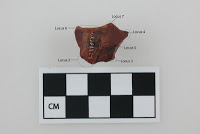 The bit of jaspar that provided this insight was discovered in 2008, 33 feet from one of the Viking longhouses. When compared with 73 jasper samples from around the world, using a handheld X-ray fluorescence device, the chemical signature of the strike-a-light showed the closest match with rocks from a 44-mile-long stretch of Notre Dame Bay known today as Fortune Harbor.
The bit of jaspar that provided this insight was discovered in 2008, 33 feet from one of the Viking longhouses. When compared with 73 jasper samples from around the world, using a handheld X-ray fluorescence device, the chemical signature of the strike-a-light showed the closest match with rocks from a 44-mile-long stretch of Notre Dame Bay known today as Fortune Harbor.Though a beachcomber might get very, very lucky, don't expect archaeologists to find--or even go looking for--any signs of the Viking presence in Fortune Harbor. As Birgitta Wallace told a reporter from the CBC, "To look for something that was a summer camp 1,000 years ago, by just a handful of people, is pretty useless. Unless there was a big catastrophe, I don't think a group of people like that leave many traces of themselves."
Join me again next Wednesday at www.nancymariebrown.blogspot.com for another adventure in Iceland or the medieval world.
Published on July 24, 2013 06:20
July 17, 2013
Viking Blood
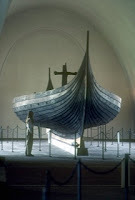 I'm descended from Vikings. People often ask me why I'm so interested in Iceland and the Icelandic sagas--why I write books about the Viking Age. My glib response has been to say, "All my ancestors come from Northern Europe, so I'm sure there was a Viking in there somewhere." But now I can legitimately say I'm descended from a Viking warrior.
I'm descended from Vikings. People often ask me why I'm so interested in Iceland and the Icelandic sagas--why I write books about the Viking Age. My glib response has been to say, "All my ancestors come from Northern Europe, so I'm sure there was a Viking in there somewhere." But now I can legitimately say I'm descended from a Viking warrior.For the sake of argument, let's call him Ragnar Lothbrok.
A few months ago, in "The Real Ragnar Lothbrok," a post about the History Channel's Vikings series, I questioned whether there was a historical person called Ragnar Lothbrok or if the character in the stories we know is a conflation of several Vikings with similar names. My source was a new scholarly book by Dr. Elisabeth Ashman Rowe, Vikings in the West: The Legend of Ragnarr Loðbrók and His Sons.
The post inspired two readers to reply that they were descended from Ragnar or from another Viking, "a close companion to Rollo" who founded Normandy, and another to suggest (sarcastically) that he himself descended from Julius Caesar and Cleopatra.
Well, an article in the new science magazine Nautilus by Veronica Green says … they are all right. They do descend from Ragnar, Rollo, Caesar, and Cleopatra. And I do descend from Ragnar Lothbrok.
You do too.
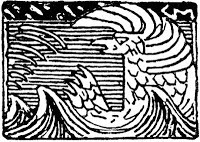 Green reports on a "a computer model of human genetics" that shows "that anyone who was alive 2,000-3,000 years ago is either the ancestor of everyone who's now alive, or no one at all."
Green reports on a "a computer model of human genetics" that shows "that anyone who was alive 2,000-3,000 years ago is either the ancestor of everyone who's now alive, or no one at all." Mindboggling as that idea is, it's too far back in time for Ragnar Lothbrok, who lived (if he lived) around 845 AD.
But Green points to an article on the National Geographic blog by Carl Zimmer, which explains that you only need to go back as far as Charlemagne (c. 800 AD) to find that you're related to everyone who lived in Western Europe (if not the world) at that time.
Zimmer was reporting on the work of Yale statistician Joseph Chang. Chang did the math: You have 2 parents, 4 grandparents, 8 great-grandparents, 16 great-great-grandparents … as Zimmer writes, "If you go back to the time of Charlemagne, 40 generations or so, you should get to a generation of a trillion ancestors. That's about 2,000 times more people than existed on Earth when Charlemagne was alive."
So you're related to all of them. Charlemagne, Ragnar, all of them.
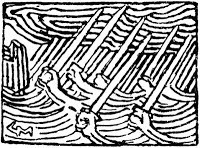 Chang's not the only scientist to come to this conclusion, Zimmer notes. A recent paper by Peter Ralph, a geneticist at USC, and Graham Coop, a geneticist at UC-Davis, looked at the DNA of 2,257 people currently living in Europe. (You can read the original paper here: http://www.plosbiology.org/article/info:doi/10.1371/journal.pbio.1001555, or a nice less-technical FAQ-sheet here: http://gcbias.org/european-genealogy-faq/)
Chang's not the only scientist to come to this conclusion, Zimmer notes. A recent paper by Peter Ralph, a geneticist at USC, and Graham Coop, a geneticist at UC-Davis, looked at the DNA of 2,257 people currently living in Europe. (You can read the original paper here: http://www.plosbiology.org/article/info:doi/10.1371/journal.pbio.1001555, or a nice less-technical FAQ-sheet here: http://gcbias.org/european-genealogy-faq/)Ralph and Coop found that huge chunks of DNA were shared by people who didn't seem like they should be related. As they explain, "We found that even people living on opposite sides of Europe are genealogically closely related to each other over the past thousand years. Even pairs of people as far apart as the UK and Turkey share a chunk of genomic material 20% of the time. Since the chance that two people inherit genetic material from any one shared ancestor from 1,000 years ago is incredibly unlikely (<10-10), to explain such sharing we need these pairs of individuals to share many ancestors. In fact, they need to share a number of ancestors that is far larger than the size of the European population, indicating that any pair of individuals share as ancestors all of the individuals alive back at the time in Europe, each many times over…. Everyone is everyone's ancestor."
As Zimmer puts it, "Charlemagne for everyone!"
Or, as I'd prefer, Ragnar Lothbrok for everyone!
Join me again next Wednesday at nancymariebrown.blogspot.com for another adventure in Iceland or the medieval world.
Published on July 17, 2013 12:06
July 10, 2013
Riding Past the Rainbow Bridge
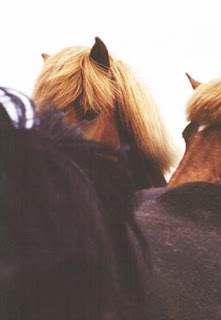 An Icelandic horse “will climb wherever a goat can clamber,” noted Sabine S. Baring-Gould in 1863. Baring-Gould, a Devonshire parson who wrote fairy tales, novels, and the hymn “Onward Christian Soldiers,” was among the many British gentlemen who went adventuring in Iceland in the 19th century. The book of his travels, Iceland: Its Scenes and Sagas, is one of my favorites, particularly for the parson’s appreciation of our horses: “An Icelandic horse is a most remarkable object,” he wrote. “As he spins along, he holds his head toward the ground, observing it intently, so that he seldom trips, and when he sees a crack or hole in the lava, he swerves rapidly and avoids it. … He will climb wherever a goat can clamber, will trot over wastes of angular stone fragments, and tread fearlessly over bogs, supported only by a network of long grass.”
An Icelandic horse “will climb wherever a goat can clamber,” noted Sabine S. Baring-Gould in 1863. Baring-Gould, a Devonshire parson who wrote fairy tales, novels, and the hymn “Onward Christian Soldiers,” was among the many British gentlemen who went adventuring in Iceland in the 19th century. The book of his travels, Iceland: Its Scenes and Sagas, is one of my favorites, particularly for the parson’s appreciation of our horses: “An Icelandic horse is a most remarkable object,” he wrote. “As he spins along, he holds his head toward the ground, observing it intently, so that he seldom trips, and when he sees a crack or hole in the lava, he swerves rapidly and avoids it. … He will climb wherever a goat can clamber, will trot over wastes of angular stone fragments, and tread fearlessly over bogs, supported only by a network of long grass.”I was riding such a horse, thankfully, on an America2Iceland trek a few weeks ago when our Icelandic guide, Halli, decided to take us cross-country. Halli, whom I described in a previous post as a man with four arms (one for the reins, one for the whip, one for his GPS, and one for a cigarette), is much like his horses: tireless, intent, fearless, and a whole lot of fun. Nothing flusters Halli. Certainly not the lack of a path.
“We’re heading for that mountain,” he assured us. “Just ride straight for that mountain, the farmer said.”
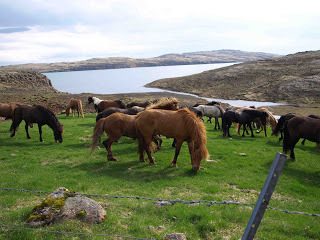 We had come from beautiful Langavatn (Long Lake), a deserted, paradisical fishing spot high above Borgarfjord, where the late evening sun glowed on the blue water.
We had come from beautiful Langavatn (Long Lake), a deserted, paradisical fishing spot high above Borgarfjord, where the late evening sun glowed on the blue water.We needed to reach Hredavatn (Bull Lake), another pretty spot closer to what qualifies as civilization in the Icelandic countryside: Hredavatn is ringed by summer houses, sheep farms, and the business college at Bifrost, with a snack bar and gas station of the same name, and close to the crater Grabrok, a popular tourist stop on the busy Ring Road, which is Iceland’s Highway Number One.
The lake was also near a tunnel under the Ring Road specifically designed for horse traffic.
Note that Bifrost is the name of the Rainbow Bridge connecting heaven and earth, over which the gods and goddesses Odin, Tyr, Freyja, and the rest ride their horses every day to hold counsel beside the Well of Weird. (Except for Thor; he’s so big he has to walk.) When a horse dies, we often say it has crossed the Rainbow Bridge. This tunnel under the Ring Road was Iceland’s attempt to limit the number of horses (and riders) that took the bridge.
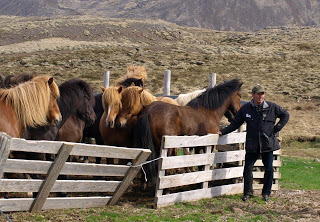 The night before, Halli had called some local farmers to confirm his route from Langavatn to Hredavatn, and thus to the tunnel. He’d learned that the traditional horse tracks through the highlands above Borgarfjord were still too wet to ride on. It had been a very late spring in Iceland. There’d been snow in some areas in late May. Riding on those sensitive paths would lead to erosion, so the farmers had sketched out an alternate route for our tour in mid-June. Emphasis on the “sketched.”
The night before, Halli had called some local farmers to confirm his route from Langavatn to Hredavatn, and thus to the tunnel. He’d learned that the traditional horse tracks through the highlands above Borgarfjord were still too wet to ride on. It had been a very late spring in Iceland. There’d been snow in some areas in late May. Riding on those sensitive paths would lead to erosion, so the farmers had sketched out an alternate route for our tour in mid-June. Emphasis on the “sketched.”“Just ride straight for that mountain,” Halli told us.
I didn’t think so. I’d ridden in Iceland many times before and had never attempted what Halli was suggesting. Between us and “that mountain” was an Icelandic forest. Not a planted forest, with imported trees growing in nice rows, as you’ll see more and more around the Icelandic countryside these days. But a real Icelandic forest. Waist-high birches just coming into leaf, their twigs bursting with fat catkins, growing so close together, their branches so interwoven, that you couldn’t see the ground. We had just left a trail, gone through a fence, crossed a stream, up a steep slope, and spotted Halli’s mountain.
I looked around. A thin line, the mere hint of a path, stretched transversely across the hilltop behind us. “There’s a path, Halli,” I said.
He looked. “Not going the right way. We need to ride straight for the mountain.”
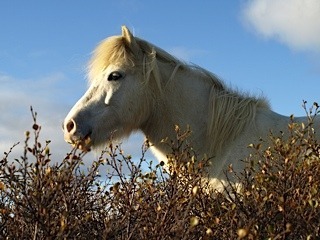 And so we did. Halli was riding a young horse with only two months of training. He had taken it on the trek so it would “get used to things” and stop being afraid. It plowed into the bushes. Yellow-green pollen burst in clouds behind it. We followed: four tourists, 15 loose horses, our riding instructor, and Halli’s daughter. We wormed and bullied our way through the forest, whose floor, we now discovered, was punctuated by sofa-sized rocks covered with moss, making the horses hop and jump—or clamber like goats—as well as twist and shove. Strangely, I did not hear a lot of branches break. The trees are as tough as the horses.
And so we did. Halli was riding a young horse with only two months of training. He had taken it on the trek so it would “get used to things” and stop being afraid. It plowed into the bushes. Yellow-green pollen burst in clouds behind it. We followed: four tourists, 15 loose horses, our riding instructor, and Halli’s daughter. We wormed and bullied our way through the forest, whose floor, we now discovered, was punctuated by sofa-sized rocks covered with moss, making the horses hop and jump—or clamber like goats—as well as twist and shove. Strangely, I did not hear a lot of branches break. The trees are as tough as the horses.“Stop there,” Halli said quietly, as he halted his horse, its feet on a boulder it was just about to clamber over. Somehow the horse managed to pivot and come back toward us. “It drops off to the river there,” Halli calmly explained.
River? Looking down the valley I could see a river. I ran my eyes back along it until it disappeared under the forest. About 100 feet under the forest, I calculated. We nearly rode over a sheer drop of 100 feet—though doubtless the horses would have noticed it even if we riders were too concerned with keeping our knees and feet on the same side of the tree trunks as the saddle was. Baring-Gould also wrote of Icelandic horses, “neither persuasion nor blows will make them tread where their instinct tells them there is danger.”
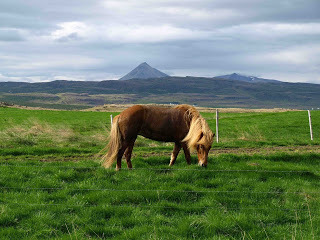 So the horses, both ridden and loose, happily turned around and made their way back to the top of the ridge. Finding myself in the lead, I started down the thread of a path I’d seen earlier. In a few minutes, it dumped me onto a real track, churned up by horse hooves, alongside a sheep fence that led “straight for that mountain” Halli wanted us to reach. Before the trail debouched into a wide pasture along the river bank, Halli scooted ahead of me, took a reading off his GPS, and waved. “Ride straight for the mountain,” he called, and laughed.
So the horses, both ridden and loose, happily turned around and made their way back to the top of the ridge. Finding myself in the lead, I started down the thread of a path I’d seen earlier. In a few minutes, it dumped me onto a real track, churned up by horse hooves, alongside a sheep fence that led “straight for that mountain” Halli wanted us to reach. Before the trail debouched into a wide pasture along the river bank, Halli scooted ahead of me, took a reading off his GPS, and waved. “Ride straight for the mountain,” he called, and laughed.We rode straight for the mountain, fording the river at a shallow spot, and walking our horses as calmly as we could through a sheep pasture dotted with days-old lambs and their mothers. Did you know that lambs’ tails wag in circles, like mini-propellers, as they nurse on their mothers?
The farmer was at the gate to let us through. He and Halli exchanged a joke—maybe about the directions? He smiled and waved us onto a gravel road right alongside the Ring Road, separated from the rush of buses, trucks, and tourist traffic only by a strand of twine that the horses were convinced was electrified. It was not. We reached the tunnel: a metal culvert just high enough for riders and horses to safely negotiate. We tolted on through, our hoofsteps echoing. We had passed Bifrost, and no one took the Rainbow Bridge.
The only casualty from our cross-country adventure? Halli lost his whip. He shrugged. “I’ve left a lot of whips out here,” he sighed.
Join me again next Wednesday at nancymariebrown.blogspot.com for another adventure in Iceland or the medieval world.
Published on July 10, 2013 07:35
July 3, 2013
The Dapple Gray
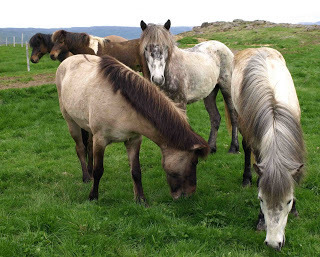 When I was in Iceland to buy horses in 1997, I fell in love with a dapple gray mare. My host, the breeder Elvar Einarsson, who was taking me around Skagafjord horse-shopping, lost his temper. “You’ll be sorry if you buy that horse,” he said.
When I was in Iceland to buy horses in 1997, I fell in love with a dapple gray mare. My host, the breeder Elvar Einarsson, who was taking me around Skagafjord horse-shopping, lost his temper. “You’ll be sorry if you buy that horse,” he said.For a moment I wondered. Were those stories about gray horses really true?
Gray (or white) horses make up an estimated 10 percent of the Icelandic horse population, yet they account for a disproportionate number of the magical horses in legends and folk tales. There’s a gray horse in the story of Fluga, the exceptionally fast mare that Thorir Dove-Nose raced against the sorceror Orn. As I wrote in an earlier blog post, "The Sorceror's Horse," Thorir won the race and Orn went up into the hills and disappeared. But when Thorir came back to fetch Fluga, he was surprised to find a gray black-maned stallion with the mare. Given that Kjolur, the highland route along which the men raced, is in the middle of Iceland, set between two of the largest glaciers, it’s unlikely this stallion wandered off from a nearby farm. Most probably, it’s the sorceror Orn himself.
Another story in the medieval Book of Settlements is that of Audun Stoti and the gray horse of Hjardarvatn. One day, a dapple gray horse came racing down out of the hills. It scattered Audun’s herd and bowled over his stallion. Audun was a big and powerful man, so he went out and caught the newcomer. He hitched him up to a sledge and spent the morning hauling in the hay from the homefield. The work went well until the afternoon. Then the gray horse started stamping. By evening, he stamped so hard his hooves sank into the ground up to his fetlocks. When the sun went down, he broke free of his harness, raced back to the hills, and disappeared into the lake, “and that was the last anyone ever saw of him.”
The horse that lives in a lake in Iceland is called a nykur or "nicker." They are always gray, and can usually be identified by their hooves: turned back to front. They should never be ridden. The Old Icelandic dictionary known as Cleasby-Vigfusson calls them a kind of “sea goblin,” and notes that they can take on other shapes than that of a horse. In this they are like the Scottish water horse, or kelpie, which can also appear as a gnome or an elf. A kelpie waits by the side of a river until he sees travelers approaching. Then he assumes his horse’s shape and drags to the riverbottom anyone foolish enough to mount him. In Iceland, at least the nicker waits for the magic words.
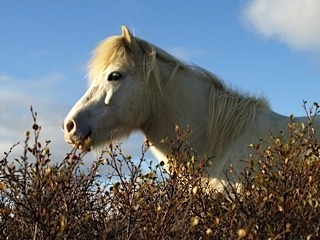 There once was a shepherd girl, one story goes, searching for some ewes that were lost. She was quite tired and a long way from home when suddenly she saw a gray horse standing by a lake. She caught it and tied on a piece of string for a bridle. Then suddenly she lost her nerve. “I don’t feel like riding this horse,” she said. At that the horse jumped into the water and disappeared.
There once was a shepherd girl, one story goes, searching for some ewes that were lost. She was quite tired and a long way from home when suddenly she saw a gray horse standing by a lake. She caught it and tied on a piece of string for a bridle. Then suddenly she lost her nerve. “I don’t feel like riding this horse,” she said. At that the horse jumped into the water and disappeared.Another time three children were playing on the bank of a river when they noticed a gray horse standing nearby. They went up to look at it, and one of them bravely clambered onto its back. When the horse didn’t spook, a second child climbed on. “Let’s go for a ride,” they called to their brother, but the oldest child refused. “I don’t feel like riding this horse,” he said. No sooner were the words out of his mouth, than the horse leaped into the river and the two children drowned.
The most fearsome gray horse in Icelandic lore is not a water horse but a fire horse. Late in the classic Njal’s Saga, just before Flosi burns the house down around the ears of Wise Njal and his wife and sons, a boy living nearby wakes in the night to hear a tremendous crash. Both earth and sky seemed to quake. “He looked to the west, and thought he saw a ring of fire with a man on a gray horse inside the circle, riding furiously.” The man was as black as pitch, and held high a flaming firebrand. As he rode, he roared out a verse:
I ride a horse
With icy mane
Forelock dripping,
Evil bringing.
Fire at each end,
And poison in the middle…
He hurled his firebrand, “and a vast fire erupted, blotting the mountains from sight.” It was the “witch-ride,” the saga says, “a portent of disaster.” (A modern reader might be inclined to call it a volcanic eruption—still a disaster.)
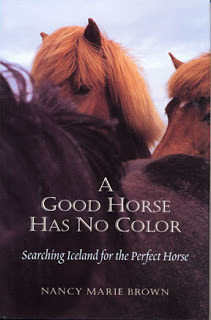 Elvar Einarsson, when he tried to talk me out of taking home the lovely dapple gray mare I’d seen in Skagafjord, probably knew all of these old stories. But that wasn’t why he warned me against buying her. The problem with this gray horse was her gaits: She didn't tolt, she piggy-paced.
Elvar Einarsson, when he tried to talk me out of taking home the lovely dapple gray mare I’d seen in Skagafjord, probably knew all of these old stories. But that wasn’t why he warned me against buying her. The problem with this gray horse was her gaits: She didn't tolt, she piggy-paced.I learned the history and folklore of Icelandic horses to write my first book, A Good Horse Has No Color: Searching Iceland for the Perfect Horse, which I'm now delighted to say is back in print! You can purchase copies of the paperback (or ebook) from Amazon.com, or meet me at Iceland Affair in Winchester Center, CT on July 20 for an autographed copy. Autographed copies will also soon be available at my local independent bookstore, Green Mountain Books in Lyndonville, VT. Call Kim to order.
Join me again next Wednesday at nancymariebrown.blogspot.com for another adventure in Iceland or the medieval world.
Published on July 03, 2013 09:17
June 27, 2013
Names for the Sea
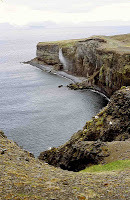 British writer Sarah Moss and I are kindred spirits. Shortly after I visited Greenland to see Viking Age archaeological sites in 2006, I read her novel Cold Earth, in which strange things happen during an archaeological investigation in Greenland. The novel remains one of my favorites, recommended to many friends, so it's no surprise I bought her memoir about a year in Iceland, Instead, I visit frequently and I read a lot about Iceland--though most of what I read disappoints me. American journalists always seem to have landed on some other island that bears no relationship to the Iceland I've known and loved since 1986. For one thing, I've spent very little time in the city of Reykjavik, particularly the city these journalists seem to find, with its "diverse milieu of funky cafes, cutting-edge restaurants and Icelandic-chic bars, all catering to a cozy chat society that hummed late into the infinite night" (NY Times, January 18, 2013), and where "half the country appears to take it as a professional obligation to drink themselves into oblivion and wander the streets until what should be sunrise" (Vanity Fair, April 2009).
British writer Sarah Moss and I are kindred spirits. Shortly after I visited Greenland to see Viking Age archaeological sites in 2006, I read her novel Cold Earth, in which strange things happen during an archaeological investigation in Greenland. The novel remains one of my favorites, recommended to many friends, so it's no surprise I bought her memoir about a year in Iceland, Instead, I visit frequently and I read a lot about Iceland--though most of what I read disappoints me. American journalists always seem to have landed on some other island that bears no relationship to the Iceland I've known and loved since 1986. For one thing, I've spent very little time in the city of Reykjavik, particularly the city these journalists seem to find, with its "diverse milieu of funky cafes, cutting-edge restaurants and Icelandic-chic bars, all catering to a cozy chat society that hummed late into the infinite night" (NY Times, January 18, 2013), and where "half the country appears to take it as a professional obligation to drink themselves into oblivion and wander the streets until what should be sunrise" (Vanity Fair, April 2009).Never seen it. Granted, I'm never out wandering the city streets in the wee hours looking for it. Reykjavik to me is a city of libraries, museums, and bookstores--especially bookstores, some of which I'll grant are funky (like the one inside the weekly flea-market at Kolaportid), and which I wish were open until what should be sunrise.
Sarah Moss, in Names of the Sea, doesn't dwell on the drunken nightlife. She's in Iceland to teach English literature at the university, with a husband and two young children in tow. But her Iceland is still not my Iceland. In a year she seems to have rarely left the city. And she never discovered the joys of the bookstores. She does not read Icelandic, she confesses. I'll forgive her that. Icelandic is a very difficult language to learn.
But Moss also doesn't seem to have read much Icelandic literature in translation. Particularly, in a whole year of living in the country, Moss doesn't seem to have read a single Icelandic saga.
That is harder for me to understand. Iceland without its sagas is just not Iceland. Iceland's medieval manuscripts, in which the sagas are preserved, "are at one and the same time the repository of medieval Icelandic culture and its visible symbol," according to the 2004 book The Manuscripts of Iceland. They are Iceland’s "main source of pride."
Only someone who had never read an Icelandic saga could write, as Moss does:
"The sagas are long narrative poems about the settlement years, which were first written down in the 12th and 13th centuries, several hundred years after the events they describe. In the 20th century, Icelandic historians questioned the status of the sagas as historical truth, and the poems are now widely seen as literary artefacts, but there is still something of the sacred text about them. Many Icelanders can quote the sagas in the way that 17th-century Puritans quoted the Bible. Every so often, a discussion in a faculty meeting will end with someone saying something in Icelandic alliterative verse. … everyone else will be nodding and agreeing, the issue somehow resolved, and I'll know the sagas have spoken again. They combine the functions of the Bible and the Domesday Book…"
Poems? Narrative poems?? At first I thought it was a typo, and Moss meant to say "the sagas are long narratives." But no, she repeats the word poems and even believes her fellow academics were quoting the sagas when they said something in alliterative verse. They were not.
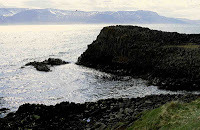 Moss has missed the whole point of the sagas' literary-historical importance. The Icelandic sagas are not poems. If someone was quoting alliterative verse, they were probably quoting the Poetic Edda, or maybe just a proverb.
Moss has missed the whole point of the sagas' literary-historical importance. The Icelandic sagas are not poems. If someone was quoting alliterative verse, they were probably quoting the Poetic Edda, or maybe just a proverb.The Icelandic sagas are "the envy of most world literatures," according to scholar William Ian Miller, because they are not poems: The sagas are written in prose. About 40 tales, some as quick as a short story, others stretching to several volumes in today’s paperback translations, make up the corpus. They tell of Iceland’s Golden Age, the Saga Age, 400 years of a free republic before the island succumbed to Norwegian rule in 1262. And they tell it beautifully: "This is not only the stuff of art," said Miller, "it is the stuff of a confident art that needs no instruction in sophistication."
In the 13th century, when verse was the norm in Europe, Icelanders were writing a vernacular prose that "achieved a height of excellence which can only be paralleled in modern times," declared E. V. Gordon, author of the standard Old Icelandic grammar book.
Peter Hallberg, who wrote a college text on the sagas, compared their style to Hemingway’s, with its simple, lucid sentence structure and finely calculated artistic effects. And there is none of that “metaphysical brooding,” in Hallberg’s words, that make medieval works like Dante’s Divine Comedy, for example, so tedious.
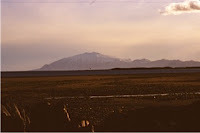 The sagas are Iceland’s claim to literary fame. Literary scholars have called them "muscled, powerful narratives" that are surprising in their "seductiveness." They have inspired countless authors, from Kipling and Longfellow to Milan Kundera and Günter Grass.
The sagas are Iceland’s claim to literary fame. Literary scholars have called them "muscled, powerful narratives" that are surprising in their "seductiveness." They have inspired countless authors, from Kipling and Longfellow to Milan Kundera and Günter Grass. J. R. R. Tolkien found much of his Middle Earth in Icelandic literature; he and C. S. Lewis started a saga-reading club at Oxford University and translated the texts from Old Norse, the Viking language.
Another saga translator was the Victorian writer and designer William Morris. Asked once if he was going on a trip to Iceland, Morris replied, "No, I am going on a pilgrimage to Iceland."
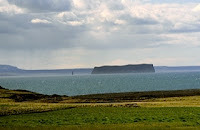 Quoting Morris, the Argentine poet Jorge Luis Borges said, "This is also my answer. Any specialist in Anglo-Saxon literature is sooner or later drawn to Icelandic literature. It is like admiring a sunset or falling in love."
Quoting Morris, the Argentine poet Jorge Luis Borges said, "This is also my answer. Any specialist in Anglo-Saxon literature is sooner or later drawn to Icelandic literature. It is like admiring a sunset or falling in love." The American novelist Jane Smiley ranks the sagas beside the works of "Homer, Shakespeare, Socrates, and those few others who live at the very heart of human literary endeavor."
I enjoyed Names for the Sea. It was fun to see Iceland through the eyes of a sensitive observer to whom everything was new--the light on the mountainsides, the cruel shapes in the lava, the misty rain, the ever-present sea. I envied her her ability to knit. But Moss's Iceland--without sagas!--is not my Iceland.
Join me again next Wednesday at nancymariebrown.blogspot.com for another adventure in Iceland and the medieval world.
Published on June 27, 2013 08:11
June 19, 2013
The Weather-wise Horse
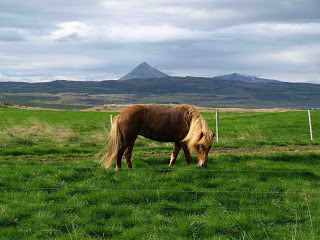 Riding a horse in Iceland is like traveling back in time a thousand years--there are so many stories about horses from the Icelandic sagas that come to mind. Many of the horses in the sagas have unusual intelligence and character. There’s Kengala, for instance, in Grettir’s Saga, which was written in the 1300s. I learned of Kengala while researching my book, A Good Horse Has No Color: Searching Iceland for the Perfect Horse, in the late 1990s and was surprised recently to notice a Kengala in the pedigree of my own mare, Mukka, born 2002.
Riding a horse in Iceland is like traveling back in time a thousand years--there are so many stories about horses from the Icelandic sagas that come to mind. Many of the horses in the sagas have unusual intelligence and character. There’s Kengala, for instance, in Grettir’s Saga, which was written in the 1300s. I learned of Kengala while researching my book, A Good Horse Has No Color: Searching Iceland for the Perfect Horse, in the late 1990s and was surprised recently to notice a Kengala in the pedigree of my own mare, Mukka, born 2002.The Kengala of the sagas was a dun-colored mare with a dark stripe down her back. The meaning of her name is obscure, but could come from kenna, “to know,” or kengur, “a bowed back.” She was owned by the farmer Asmundur, Grettir’s father, and was “so wise about the weather” that a storm invariably followed when she refused to graze. “If she does this,” Asmundur told Grettir, “you are to stable the horses, but otherwise keep them grazing up north on the ridge, once winter sets in.”

Grettir was a rebellious teenager and hated the chores his father gave him. This one, at least, was “man’s work,” as he put it, and things went well until “it became cold and snowy with poor grazing. Grettir was thinly clad and not yet fully hardened, so he began to feel the cold bitterly, but Kengala grazed away in the most exposed places during the worst of the weather.” Grettir resented having to obey the horse’s weather-sense, and one morning he came to the stable with a sharp knife and jumped onto her back. “There was a fierce struggle, but in the end he succeeded in cutting loose her back skin all the way to her loins”—essentially flaying off her dorsal stripe. When he drove the horses out to pasture that day, Kengala, not surprisingly, ran straight back to the barn.
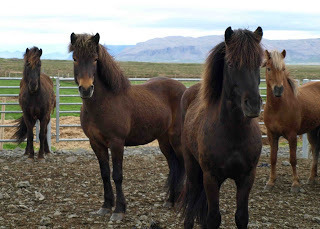
Asmundur was alarmed to hear that Kengala refused to graze, and told the household to prepare for a blizzard. After two nights and still no sign of a storm, he went out to the stable to see Kengala for himself. Greeting his favorite mare, he ran his hand along her back and was horrified to find the skin coming away at his touch. Grettir stood there grinning; his father “went home swearing violently.”
The weather-wise Kengala had to be put down, but Grettir also came to a bad end, living most of his life as an outlaw, chased from place to place. Some people reading Grettir’s Saga think of the outlaw as a tragic hero. From the horse’s perspective (and mine), he got what he deserved.
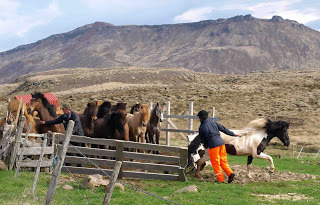
The translation of Grettir’s Saga that I like is the one by Denton Fox and Hermann Palsson (University of Toronto Press, 1974). You can read more about this saga on my friend Emily Lethbridge’s blog, Sagasteads of Iceland (http://sagasteads.blogspot.com/search?q=grettir%27s+saga).
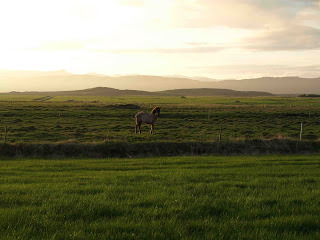
The Icelandic Horse Quarterly, where I published a version of this story in 1998, is the official breed publication of the Icelandic Horse Congress; I am on the editorial committee. Visit the congress’s website (www.icelandics.org) to read a free copy and learn more about Icelandic horses today, or take a virtual ride on my friend Stan Hirson’s video blogs, Hestakaup.com and Life with Horses (http://www.lifewithhorses.com/)
Join me again next Wednesday at nancymariebrown.blogspot.com for another adventure in Iceland or the medieval world.
Published on June 19, 2013 04:42
June 12, 2013
My America2Iceland Lesson
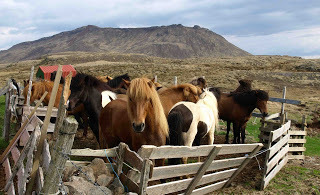 We were six riders and 20-some horses. "Do you want to be in front or in back?" asked our riding instructor, Gudmar Petursson. The loose horses would be sandwiched between us for our day's ride of 30 kilometers, from Gudmar's farm, Stadarhus, up to Langavatn, the Long Lake, in the highlands of Iceland's Borgarfjord district. It was the first of four days of horse-trekking, in a tour the company America2Iceland designed around my book Song of the Vikings.
We were six riders and 20-some horses. "Do you want to be in front or in back?" asked our riding instructor, Gudmar Petursson. The loose horses would be sandwiched between us for our day's ride of 30 kilometers, from Gudmar's farm, Stadarhus, up to Langavatn, the Long Lake, in the highlands of Iceland's Borgarfjord district. It was the first of four days of horse-trekking, in a tour the company America2Iceland designed around my book Song of the Vikings.I chose the back. I would see the herd running ahead of me--a splendid sight, a splash of color in the otherwise muted landscape of moss and lava rock, sand and just-greening grass. I could chum with Gudmar, who would be cowboying. And I would have more control over my horse's speed. Or so I thought.
I'd ridden Magnus, my morning horse, twice during the previous two days of riding clinics under Gudmar's direction: once in the indoor arena and once on a two-hour trek. I loved him. Magnus was not a flashy horse. No pretty color, no impressive mane. Gudmar had introduced him to me as "that ugly one over there. The one who needs a brushing."
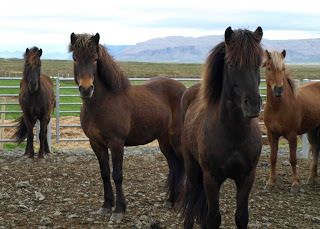
He's the one at the far left in this picture. He might have been black. He still had reddish patches of winter coat and his dull gray forelock seemed stuck with glue. He came right up to me and let me scratch his forehead, which he'd obviously been rubbing against a fence post. Before tacking up, I spent a long time with the curry comb, removing knots and fuzz; he stretched his neck down and sighed. When I paused he swung his big head toward me, as if to say, more, please.
"I think he likes that," Gudmar said, before pointing out (again) where I could find a saddle.
In the arena, Magnus was very smooth, with a big, ground-covering tolt, the signature running-walk gait of the Icelandic horse. He was heavy on the reins, but I preferred that to the first horse I rode, who was so light in the mouth that a feather touch was too much. (We will not mention the fact that the bit was in upside down and backwards; I wasn't the one who put the bridle together).
So before we headed out on our first all-day trek, Magnus and I waited, patiently, with Gudmar and Ian, while Halli (our trekking guide), Kathy (below), Julia, and the loose horses passed us by. Then we started off from the barn.
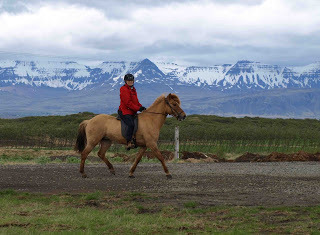
And Magnus reassessed the situation. He passed Gudmar and Ian. He began weaving in among the loose horses. I hauled on the reins: nothing. He began cantering--or at least, cantering with the back end. It was not a gait in the books. I yelled at him. No use.
"Just go with it," Gudmar shouted.
So I went with it. Magnus settled back into his long-stepping, ground-covering, smooth-as-a-rocking-chair tolt and in short order we were leading the parade and could slow down to a comfortable speed, just fast enough to stay in front. I relaxed. I would be riding in front all day, I knew, and so it turned out.
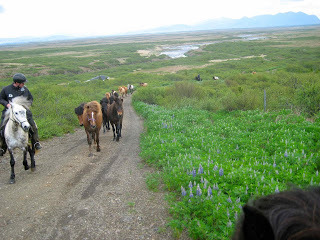
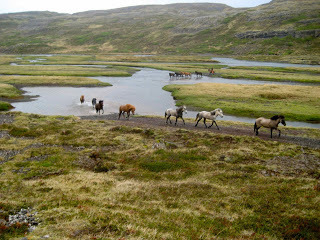
I saw amazing scenery (Ian took these two photos before his camera died). We rode along the rushing River Langa, a prime fishing stream apparently, with dozens of marked pools. We passed spectacular rapids and rode up a steep ridge to a rugged farm squeezed in at the base of the cliffs. We crossed the river four, or five, or six times--I lost count.
We left the river-road and headed cross-country, our path a combination of Halli's dead-reckoning and frequent glances at his GPS unit, which he managed to read while riding along at a good clip over boulders the size of bowling balls, through bogs, and along crumbly scree slopes. Halli (below) has four hands, I'm convinced: one for the reins; one for the whip, which he extends sideways to keep the loose horses behind him; one for his GPS; and one for a cigarette.
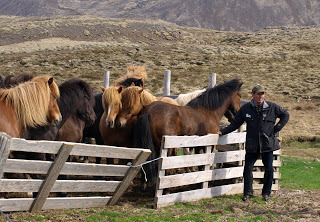
I rode in front even after lunch, when we changed horses. Which, of course, begs the question. Was it only Magnus who was most comfortable in front? Riding on a horse-trek in Iceland is sometimes like taking a personality test: Do you want to be in front, leading by example, or in back, chivvying the loose horses along and keeping them in line? Being a follower is not an option. Only riderless horses are followers.
Join me again next Wednesday at nancymariebrown.blogspot.com for another adventure in Iceland or the medieval world.
Published on June 12, 2013 01:37
June 5, 2013
An Icelandic Horse (hair) Tale
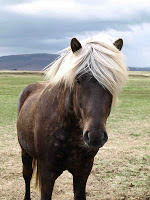 Icelandic horses have a lot of hair, as anyone who has seen one knows. According to the breed standard, "a long, thick mane and tail" and a "thick, protective coat in winter" are typical. "Shaggy" is the word that usually comes to mind.
Icelandic horses have a lot of hair, as anyone who has seen one knows. According to the breed standard, "a long, thick mane and tail" and a "thick, protective coat in winter" are typical. "Shaggy" is the word that usually comes to mind.Of course it's cute. But that long mane and tail, in the old days, was an important resource on Iceland's farms, as I found out this week while visiting two of Iceland's museums.
The first was the Folk Museum at Skogar, in the south of the country. In addition to a collection of old houses, fully furnished, there's a separate building of several rooms stuffed with what can only be described as, well, stuff.
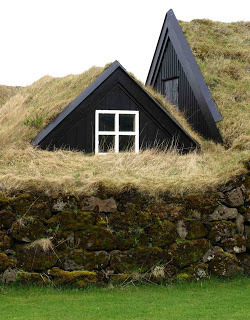
There are books and embroideries and a two-stringed fiddle. There are birds' eggs, skeletons, rocks, pinned insects, pressed flowers, and a stuffed two-headed sheep. There are busts of several local dignitaries and two paintings by one of Iceland's most famous artists, Kjarval, in the basement, along with some mid-20th-century living room furniture and a famous writer's studio. There's a fishing boat. There's an excellent description of how to make spoons from cows' horns.
And alongside a collection of butter churns and side-saddles and children's toys (made of bones) were what caught my eye: beautiful bags and ropes made of different colors of horse hair.
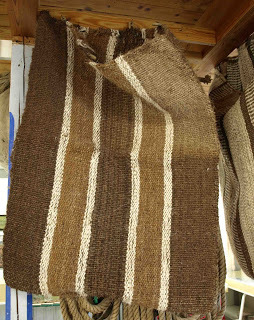
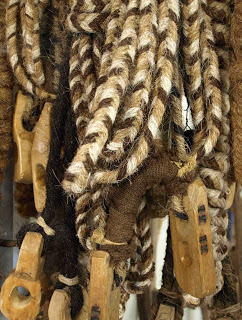
The second museum I visited was the Skagafjordur Heritage Museum at Glaumbaer in the north. It's a place I know well. I visited it in 1997--on horseback--while researching my book A Good Horse Has No Color: Searching Iceland for the Perfect Horse, and worked there as a volunteer on an archaeological dig in 2005, while researching my second Iceland book, The Far Traveler: Voyages of a Viking Woman. In addition to a Viking Age longhouse (now reburied and awaiting further excavation), there's a well-preserved turf house at Glaumbaer, part of it dating to the 17th century, and a cafe famous for its fish soup and its cheesecake made from Icelandic skyr, a kind of yogurt.
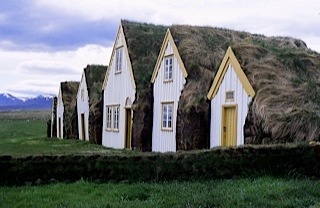
Glaumbaer's curator, Sirri Sigurdardottir, told me that a woman in Skagafjordur still made things out of horse hair. She clipped the hair from the horses' manes and tails and hand-spun it with a spindle, then braided it into rope. Sirri showed me a sample--it turned out I had taken a photo of some matching rope objects at Skogar, not knowing exactly what they were.
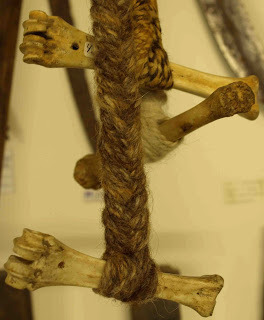
They are hobbles, Sirri explained. There's a loop at one end and a sheep bone at the other end of each rope. You twist the rope around your horse's feet and lock it with the bone so that your mount won't stray at night. At least, that's how these hobbles originally were used. Today the museum store at Glaumbaer sells them ... as wedding gifts. They're very popular, Sirri says.
Icelanders do have a well-developed sense of humor.
Join me again next Wednesday at nancymariebrown.blogspot.com for another adventure in Iceland or the medieval world.
Published on June 05, 2013 03:38
May 29, 2013
Freyfaxi the Saga Horse
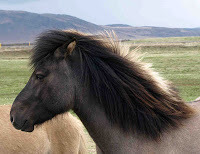 Traveling about Iceland, it's impossible not to stop and take some pictures of the horses and, of course, to remember all the stories of horses in the Icelandic sagas. One of the most famous Icelandic horses appears in Hrafnkel’s Saga, which is set early in Iceland’s history. I first read the saga, and fell in love with the stallion Freyfaxi, while learning Old Norse at Penn State University in the early 1980s. In my book A Good Horse Has No Color, I write about riding a real Freyfaxi: smooth and powerful and unfortunately not for sale.
Traveling about Iceland, it's impossible not to stop and take some pictures of the horses and, of course, to remember all the stories of horses in the Icelandic sagas. One of the most famous Icelandic horses appears in Hrafnkel’s Saga, which is set early in Iceland’s history. I first read the saga, and fell in love with the stallion Freyfaxi, while learning Old Norse at Penn State University in the early 1980s. In my book A Good Horse Has No Color, I write about riding a real Freyfaxi: smooth and powerful and unfortunately not for sale.Iceland was settled between 870 and 930 and became Christian through a decision by the Althing, the yearly meeting of the chieftains, in the year 1000. Before that time Icelanders worshiped the gods Odin, Thor, and Freyr (among others).
The chieftain Hrafnkel owned a dun-colored horse, a fine stallion with a black mane. He dedicated the horse to the god Freyr and named it Freyfaxi, fax meaning “mane.” Although Hrafnkel was well-off, Freyfaxi was the “one treasured possession which he held dearer than anything else he owned,” the saga says. “Hrafnkel loved this horse so passionately that he swore a solemn oath to kill anyone who rode the stallion without his permission.” In the sagas, such an oath is usually regretted.
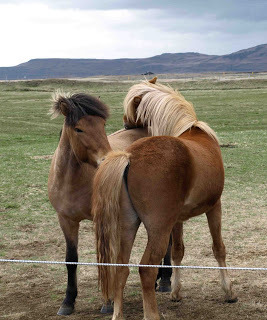 Hrafnkel hired his poor neighbor’s son, Einar, a promising young man, as his shepherd and warned him not to ride Freyfaxi. All went well until midsummer, when Einar lost track of 30 of Hrafnkel’s sheep. They went missing for a week, and finally he took a bridle and saddlecloth and went to catch a horse to help him search. “But when he came closer, all the mares bolted away from him, and he chased them without success. They had never been so shy before. Only Freyfaxi remained behind; he was as still as if he were anchored to the ground.”
Hrafnkel hired his poor neighbor’s son, Einar, a promising young man, as his shepherd and warned him not to ride Freyfaxi. All went well until midsummer, when Einar lost track of 30 of Hrafnkel’s sheep. They went missing for a week, and finally he took a bridle and saddlecloth and went to catch a horse to help him search. “But when he came closer, all the mares bolted away from him, and he chased them without success. They had never been so shy before. Only Freyfaxi remained behind; he was as still as if he were anchored to the ground.”Foolishly, Einar rode Freyfaxi “from dawn to mid-evening, traveling fast and far, for this was an outstanding horse.” By the time they found the lost sheep, “Freyfaxi was all running with sweat; and every hair on his body was dripping. He was covered in mud and panting from exhaustion.” As soon as Einar loosed him, “he rolled over a dozen times, and the neighed loudly and started to race down the path.” He ran right to the farmhouse, “came up to the door and neighed loudly.”
Hrafnkel, who was just sitting down to dinner, recognized the neighing and went out. “It grieves me to see how you have been treated,” he said. “You had your wits about you when you came to me, and this shall be avenged. Go back to your herd.”
The next morning Hrafnkel rode up to the sheep pens and killed Einar. But, regretting his oath, he offered to provide Einar’s father with all the milk and meat his household needed from then on and to give Einar’s younger brothers and sisters “a good start in life.”
Einar’s father refused. With the backing of some powerful men from another part of Iceland, he and a kinsman managed to strip Hrafnkel of his authority and possessions, even stringing him up by his heels to torture and humiliate him before chasing him out of the district. They led Freyfaxi up to a steep cliff beside a waterfall, put a bag over his head, tied a stone around his neck, and used heavy poles to push him over, saying sarcastically that they were sacrificing him to the god Freyr.
 Clearly they had overstepped the bounds of justice. As the saga tells it, Hrafnkel worked his way back to prosperity and popularity until finally he resumed his place as leader of the district and “enjoyed great prestige” before dying peacefully in his bed, while his enemies were punished by being reduced to the status of servants.
Clearly they had overstepped the bounds of justice. As the saga tells it, Hrafnkel worked his way back to prosperity and popularity until finally he resumed his place as leader of the district and “enjoyed great prestige” before dying peacefully in his bed, while his enemies were punished by being reduced to the status of servants.But that didn’t bring back Freyfaxi. I’ve often longed to rewrite that story—and change the ending.
Hrafnkel’s Saga was translated by Hermann Palsson (Penguin Books, 1971). You can read more about this and other sagas on my friend Emily Lethbridge’s blog, Sagasteads of Iceland (http://sagasteads.blogspot.com).
The Icelandic Horse Quarterly, where I first published this story in 1998, is the official breed publication of the Icelandic Horse Congress. Visit the congress’s website (www.icelandics.org) to read a free copy and learn more about Icelandic horses today, or take a virtual ride on my friend Stan Hirson’s video blogs, Hestakaup.com and Life with Horses (http://www.lifewithhorses.com/)
Join me again next Wednesday at nancymariebrown.blogspot.com for another adventure in Iceland or the medieval world.
Published on May 29, 2013 02:05
May 22, 2013
Viking Language
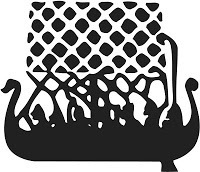 Viking Language 1 by Jesse Byock is the book I was looking for 30 years ago when I decided I had to learn to read the Icelandic sagas in the original.
Viking Language 1 by Jesse Byock is the book I was looking for 30 years ago when I decided I had to learn to read the Icelandic sagas in the original.As I wrote in my first book, A Good Horse Has No Color: Searching Iceland for the Perfect Horse, I'd been introduced to the sagas in my second year of college by a professor of folklore, Sam Bayard, an impish man, small, bald, rotund, and hunched like a wise turtle walking upright. He had an impressive nose, which he periodically aroused with snuff taken from one of the half-dozen boxes secreted in his pockets. He would courteously offer me some, smile when I declined, then, snuffling up a liberal pinch, harrumph into a large handkerchief which he subsequently used to brush the dust off his breast. His snuff boxes were antiques, portable works of art carved of horn, cast in silver or brass with ancient scenes of hunts or warfare, shaped of handsome woods. Another pocket held a tin whistle, which he'd occasionally demonstrate. A fiddle hid in his filing cabinet. A narrow bookshelf along one wall was crammed with Icelandic sagas, which he loaned to me, one after the next.
When the translations proved stilted or old-fashioned or, worse, non-existent, I decided I needed to learn Old Norse. The professor who taught me the language, Ernst Ebbinghaus, was an icon of his occupation—high forehead, aquiline nose, a halo of silky white hair. He wore French cuffs and ascots. I found him inordinately distant and stiff, traits I linked to his European training. He was Old School, German-educated. He even knew Sanskrit. We translated bits of sagas into our notebooks, puzzling over the three genders and four cases, singular and plural, into which the grammar slotted the words, memorizing the 24 different forms of such essentials as "the" or "this" or "who." Ebbinghaus stood above us and explicated such words as ójafnaðarmaðr: the unjust, overbearing man, the man who upsets the balance of the world. He refused to hazard pronunciation. No one knew how to pronounce Old Norse, he said. The language was dead. Like Latin. I found that vastly disappointing.
Fortunately, before much longer, I went to Iceland for the first time and learned that Old Norse wasn't "dead" after all. It had just shifted into Icelandic, changing about as much as English has since Shakespeare's day. Neither are the sagas of only antiquarian interest in Iceland. They are alive, part of—and preserved by—the landscape. Icelandic schoolchildren study the sagas in history class. Modern Icelanders trace their family trees to heroes in the old tales. The medieval past is remembered in the name of every hill and farmstead. There is a saga everywhere you turn.
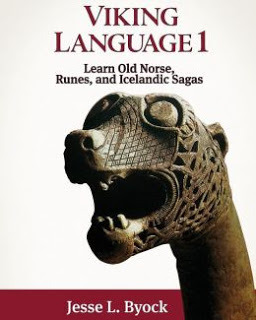
Jesse Byock's book Viking Language 1 takes all this into consideration. The full title is Viking Language 1: Learn Old Norse, Runes, and Icelandic Sagas, but the back cover blurb clearly describes the book as "an introduction to Old Norse and Icelandic. The beginner has everything in one book: graded lessons, vocabulary, grammar, exercises, pronunciation, culture sections, and maps. The book follows an innovative method that speeds learning. Because the grammar of Modern Icelandic has changed little from Old Norse, the learner is well on the way to mastering Modern Icelandic" (my emphasis).
That said, Byock's book has also solved a mystery for me. I've spent 30 years reading Old Norse. I can sit down and read a saga and enjoy it. I can even translate it. But I've been trying to learn Modern Icelandic for the same length of time, and every time I return to Iceland (and I'm currently on trip number 17), I feel like I'm starting over. I'm grasping for words, entirely unable to express myself. I feel like an infant just learning to talk. I'm proud when children will converse with me. To write a simple letter I have to surround myself with dictionaries.
Why? Byock has the answer. He's structured his book around it: "The total vocabulary of the sagas is surprisingly small," he writes. "Excluding names, there are only 12,400 different words in the corpus of the family sagas out of a total word count of almost 750,000. The 70 most frequently used words account for nearly 450,000 or 60% of the total word count. As one might expect this 70 contains the most frequently repeated prepositions, pronouns, conjunctions, verbs, and adjectives. The greatest benefit is found in learning the 246 most frequent words…"
His Appendix B gives helpful lists of them--and I'm happy to say, I know all 246 words. But just a glance at the list of 50 most common nouns explains why I'm able to read the sagas but not converse with my friends. The most common noun, maðr or "man," is still useful. But next come "king," "ship," and "speech (or lawsuit)." "Wealth" is number 7. "Sword" is 29, "slaying" is 35, "weapon" is 41, "spear" is 45, "shield" is 50 … you get the point. Lucky for me that "journey" is number 17, "horse" is 22, and "friend" is 36.
For information on Jesse Byock's Viking Language 1: Learn Old Norse, Runes, and Icelandic Sagas go to www.vikingnorse.com. There you can even hear someone read Old Norse aloud.
Join me again next Wednesday at nancymariebrown.blogspot.com for another adventure in Iceland or the medieval world.
Published on May 22, 2013 10:01



